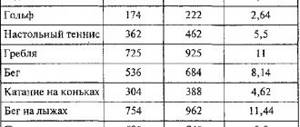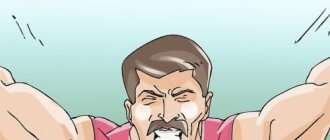Three approaches to training frequency
Set 1 - only 3 workouts per week (1+1+1)
Train three times a week. This school is suitable for you if you are a beginner or are training to maintain your tone. By working out 3 times on different muscle groups once each, your muscles will have time to rest, and you will be happy to go to workouts. If you are a professional athlete or want to lose weight quickly, then this school is not for you.
Approach 2 - short training up to 6 times a week (2+2+2)
If you want progress, exercise 6 times a week. Beginners should not train using this system, as this can lead to overtraining, as well as unwanted injuries. You won't get good results and will most likely stop training. Again, some successful athletes and Bulgarian lifters supported this approach.
If you still choose this school, then you should not train for more than an hour. You will tire your body and your muscles will not have time to recover. Your training will not bring the desired result. And here are tips on this topic from Ekaterina Usmanova for girls to train their buttocks.
Ekaterina says that, unlike men, girls have problem areas in the hips and buttocks. Therefore, men's and women's glute workouts will be very different. Men just need to do the base to increase volume, but girls need to do the shape.
Most girls have a pear-shaped body and it is much more difficult to work out the bottom. Usmanova suggests training your buttocks 3 times a week. One workout will include a core workout (e.g., squats, lunges, deadlifts), and the other 2 workouts will focus on butt shaping and include isolation exercises.
The exercises in these workouts should be constantly varied. These can be the same squats, only without weights and for a large number of repetitions; simply the placement of the legs, abduction, extension of the legs in the simulator, and so on can change.
You can also follow the standard path: train for weight, include 1 basic workout per week in the training process, and then, during drying, add more isolation exercises to the program that will draw the shape of your buttocks.
Important!
You should not go to training if you have a cold or feel weak. So, you can only harm your body, and besides, such training is unlikely to bring you good results and satisfaction
.
Cardio exercises
If you are physically fit, have been involved in some kind of sports, and lead an active lifestyle, then you can immediately include the cardio exercises described below in your training program. If you are starting exercise for the first time, then start with running, dancing and swimming. And only after that, move on to cardio exercises. A single cardiological exercise is not difficult in itself. The load on the heart and active energy consumption appear with a large number of repetitions. Each of the described movements is performed several dozen times. This provides work to the blood vessels and heart, and also causes severe sweating and weight loss.
The number of approaches is tens of times. Each exercise is performed for 20-30 or 50-100 repetitions. The number of repetitions is chosen according to how you feel. At first, 20-30 repetitions in 2-3 sets are enough. Later you will need to triple the load. Take short breaks between repetitions of exercises. This gives you the opportunity to catch your breath and restore your pulse. Here are descriptions of some accessible and effective movements:
- Walking/running with shin overlapping. Performed on site. The weight is transferred to one leg, and at this time the other leg rises back, as if you took a step and pushed off with the other leg. The heel of the raised leg reaches towards the buttock. After that, the second leg is lowered, the weight is now transferred to it, and the first leg rises back. So they “walk” or “run” in place, taking turns raising one or the other leg. At the same time, the hands swing backwards in time with the “steps”. The arms are spread out with the elbows partially bent.
- Raising your knees to your chest. Standing still, one leg bends at the knee and rises to the chest. When performing the exercise, you cannot stand on an even leg. The second supporting leg is “soft”, bent at the knee. At the beginning of the exercise, the arms are raised up. When raising the knee, the arms bend at the elbows and lower down, with the elbows towards the knee. A more powerful version of the same exercise is running in place while raising your knees to your chest. When doing this, you need to raise your knees as high as possible.
- Knee raise/back lunge. Performed with support on one leg. The supporting leg is soft, with the knee bent. The second one rises to the chest and then falls back to the floor. When lowering, the supporting leg bends at the knee, and the second leg is moved further behind the back. The resulting position resembles a lunge. The exercise is performed in sets - 20-50 times on one leg. And after that - 20-50 times for each other. You can strengthen and make this exercise more difficult in the following way. When lowering your leg back, your body tilts and your hand touches the floor.
- Straight leg raises - alternate between raising one leg forward and lifting the second leg back, behind your back. At the same time, the leg makes a “kick” movement - first the thigh rises, the knee is bent. After which the lower leg straightens, extending the thigh line. Similarly, back - the thigh rises and then the lower leg straightens. Lifts and “kicks” of the legs to the sides are performed in the same way.
- Side lunges - standing upright, legs take turns taking steps to the side. In this case, the weight is transferred to the leg that took the step. It turns out to be a lunge. At the same time, the arms rise from the “down” position to the “above the head” position. The lunge is made in turn, first in one direction, then in the other direction.
- Jumping in place - in this case, the legs are spread to the sides by a jump and also placed back, side by side, by a jump. The torso is tilted diagonally forward, arms are bent at the elbows and placed in front of the face. With each jump and spread of the legs to the sides, the arms also spread to the sides.
- Jumping with squats - when jumping, the legs are spread apart. At the same time, the body leans slightly forward, hands drop down to the floor. At each jump, your hands touch the floor with your fingers or palms, after which you need to “jump” up.
- Skier - jumps with his feet in place, one leg moves forward, the other jumps back. Thus, the legs change places, first one, then the second leg comes forward. At the same time, the arms help the movement by swinging forward/backward. Performing the exercise resembles a skier's move.
- Skater - the exercise is performed vertically. From the support on one leg, you need to jump over to the second leg, while the free leg goes back and touches the toe of the floor behind the heel of the supporting leg. It turns out to be a “skater’s move.” You can strengthen the exercise by additionally tilting your body and touching your hand to the floor. If the support remains on the left leg and the right leg goes back, then you will need to touch the floor in a tilted position with your right hand.
- Horizontal walking and horizontal running - the exercise is performed in a plank position. In this pose, you need to pull your knees towards you one by one. In this case, one leg is bent and pulled towards the chest, while the other remains on the floor. When you quickly change legs, you get a “run,” and when you slowly pull your legs up, you get a “step.”
- Spreading the legs in the plank - in the plank position, the legs are spread to the sides in a jump and then brought back in the jump.
- Plank jumps - in the plank position, the legs are simultaneously pulled towards the chest during the jump.
- Burpees are a very powerful exercise. In which the knees are pulled towards the chest during a jump. Afterwards, a jump is performed upward from a squatting position. Afterwards, we return to the squatting position. And then we jump back into the plank.
- Bending upward from a squat position.
Cardio exercises can involve different muscle groups. The main goal of these exercises is to tense several muscle groups, increase breathing rate, and blood flow. Lose weight and lose weight.
Cardio or strength training?
If you have clearly decided that your goal is to lose weight, then you will have to include 2-3 cardio workouts per week (remember to take into account your fitness level). It must be remembered that cardio is not only a Treadmill, it is also an Elliptical and an Exercise Bicycle. Change the load periodically to make your workouts less monotonous. An example of a 3-month training plan for weight loss for girls is always available to you.
When setting a goal to lose weight, don't limit yourself to just cardio. To achieve better and faster results, be sure to include 1-2 circuit or strength training per week. Circuit training works absolutely all muscle groups, while burning 30% more fat than a regular workout in the gym.
On topic: Home workouts from Morgacheva
Cardio loads: preparation for special cardio exercises
At the beginning of classes, the weight loss program includes cardio loads in the form of various active activities. It can be:
- Swimming;
- Walking;
- Jogging and running with acceleration, not on a treadmill or in a stadium, but also on park paths;
- Jumping - on a skipping rope;
- CrossFit;
- Step aerobics;
- Dancing;
- Bicycle or exercise bike;
- Roller skating, skating, skiing;
- Active games – volleyball, tennis, football (for men).
Be sure to read: Rules for doing exercises for weight loss - basic exercises
These cardio classes are preparatory. They are aimed at training the heart. After two weeks of preparation, you can add special cardio exercises to your fat burning training program.
Circuit training
The essence of circuit training is to quickly change between different strength and cardio exercises. In 30 minutes you can burn from 180 to 400 kcal, but the result will depend on the intensity of the exercises and the number of laps. In the article Circuit training in the gym, you can learn more about this type of training, and also include one of our variations of circuit training in your program.
Do not forget that in order to lose weight you need to spend more energy than you consume. Therefore, you can achieve the desired result only if you follow a sleep schedule and a balanced diet.
Source
Optimal training duration [edit | edit code]
The results of numerous studies show that the total amount of time spent on physical work matters, for example, 10 hours a month will be almost 2 times more effective than 5. However, the duration of each workout is not of fundamental importance. So, three thirty-minute sessions a day can give the same effect as one hour and a half workout. That is why you cannot expect to gain muscle mass or significant weight loss if you devote only 1 hour a week to training or 10 minutes a day.
The duration of the workout is also determined by the goal, the specifics of the training program and the athlete’s level of professionalism.
Duration of training for mass gain[edit | edit code]
The average workout duration that will give the best results is 1 - 1.5 hours. The training of a professional athlete should take less time, due to his narrow specialization, that is, approximately 40-60 minutes. Training for a beginner bodybuilder takes 1.5 - 2 hours, as it requires more rest time between approaches and broad specialization. Remember that each workout involves approximately 10 minutes of warm-up and 10 minutes of cool-down. Exercising too long causes an increase in the secretion of cortisol, a hormone that breaks down muscles and can also lead to overtraining.
Duration of training when losing weight [edit | edit code]
The duration of the workout when losing weight is key to the results; it should not be less than 30 minutes, since in a shorter period of time it is simply impossible to speed up metabolism and start the destruction of fat. The optimal time is 60 minutes. As training time increases, efficiency also increases, but in bodybuilding this threatens muscle destruction under the influence of catabolic processes.
Source
Weekly training plan
Muscle recovery time after exercise takes at least 48 hours, sometimes more. Therefore, you can load the same tissues two or three days after performing the exercises. How to be? After all, for highly effective fat-burning workouts, daily exercise is necessary. It is better to train twice a day. The conclusion is simple: you need a variety of loads and exercises. Namely:
- Morning and evening workouts should differ in the type of cardio loads. In the morning - running, swimming or other active play. In the evening - fitness or classes in the gym.
- To properly distribute physical activity, a weekly weight loss training plan is drawn up. It outlines daily exercises for various muscles. For example, on Monday, Wednesday and Friday the hips, buttocks, and legs are loaded. And on Tuesday, Saturday and Sunday the abs, biceps and triceps are loaded.
Using the plan, you will weigh several kilograms less in a week.
Be sure to read: Staying fit for men with circuit training
What affects the duration of a workout?
single standard for workout duration for all types of fitness: an hour of moderate-intensity cardio and an hour of HIIT have different effects on the body. Therefore, the first factor that determines the duration of a lesson is its objectives. “Each area of training has its own temporary recommendations,” says Anastasia Yurkova, master trainer of the group programs of the federal network of fitness clubs X-Fit . — They are connected with the physiological aspects of the training process and the objectives of the lesson. For example, a daily workout can last 15-20 minutes if the goal is simply to “tune” the body. This applies to morning warm-up, evening relaxation, or working on a specific aspect, for example, strengthening the gluteal muscles. Also, a class can last 1.5–2 hours if it is an endurance workout or yoga that requires a long setup.” The second factor influencing training time is the level of training. Beginners, for example, should not exercise for more than 30-40 minutes if we are talking about cardio exercises, and more than an hour if we are talking about strength training. As your training level increases, you can increase the duration of the session.
Now let's look at the duration of specific types of classes.
Duration of training for weight loss
You can train for 2, 3.4 hours, but your level of training must correspond to this, in addition, the longer and the greater the load on the body, the more time it takes to recover. For most, 1-2 hours is enough to work out in the gym. Of course, if you have chosen daily training, that is, with a frequency of 5 days a week, then 45-60 minutes will be enough for you to work out your muscles; for someone who trains with a frequency of 3 times a week, 1-2 hours will do Those who train 1-2 times a week should train for 3-4 hours in the gym, working most of the large muscles at a time.
How long should a workout last if you want to gain muscle or lose weight as quickly as possible? More physical activity does not mean better. Find a balance between training intensity, duration and recovery period to get optimal results and avoid.
On topic: Swimming training plan 1 year of training
Weight loss theory: what you need to lose weight
In order to lose weight, you need to “burn” fat reserves and excess calories. The body can burn calories only when it is deficient. When there is a lack of energy, the body consumes its own calories and loses weight. There are many ways to create a calorie deficit in the body. The main condition is that the intake of calories should be less than their expenditure. During the day, the body should receive fewer calories than it expends. You can act in two directions:
- Reduce your calorie intake from food - go on a diet;
- Increase calorie consumption - increase physical activity.
The fastest weight loss is possible with a combination of diet and exercise. Therefore, a set of workouts for weight loss is supplemented with reasonable dietary restrictions.
How long does strength training last?
It makes no sense to “pull the iron” for too long. “The recommended time for strength training is 60 minutes, including warm-up and cool-down (5-10 minutes for both), notes Anastasia Yurkova. “The main part of the workout should last 30-50 minutes; doing longer is pointless from the point of view of the biochemistry of the process, since the mechanisms responsible for endurance are activated, and not strength indicators.”
Why? The main “fuel” during exercise is glycogen, a complex carbohydrate that is stored in different areas of the body. During the first 25 minutes of training, glycogen from muscle fibers is consumed, and during the next 20 minutes, “fuel” from the liver is used. This helps the muscles work at their maximum. Further, muscle performance decreases.
Content
- 1 What influences the duration of training
- 2 Optimal training duration depending on different goals 2.1 Gaining muscle mass
- 2.2 Reducing body fat
The usual length of a health fitness workout is 60 to 90 minutes. However, recently various 10-30 minute exercise programs have appeared, the authors of which promise unprecedented results. But is this true? Research shows that what matters is the time under load in a particular exercise, and the total number of hours spent working in a certain time period. Regularity is also an important factor. 4 hours spent in the gym on one weekend does not equal four one-hour sessions spread out over the course of a week.
How long does aerobic training last?
Optimally - from half an hour to an hour. “Cardio training should be done in the range of 30 minutes or longer,” says Anastasia Yurkova. — If your goal is simply daily steady cardio for health, then doing 30 minutes is enough. But, for example, professional athletes of cyclic sports train up to 6-8 hours a day, developing endurance.”
If your goal is fat burning, it makes sense to do cardio for 40 minutes to an hour. However, your heart rate during exercise is important here - check yourself with heart rate zones .
Cardio exercises - what they do for weight loss
A fat burning training program can include various exercises. But the bulk of your exercise should be cardio. It is cardio exercises that create an energy deficit and force the blood to actively move. Performing cardio exercises increases your heart rate (called heart rate). When performing cardio, the pulse and heartbeat significantly increase, blood flow accelerates and breathing becomes frequent. This occurs due to a lack of energy for active fat oxidation. In order to provide the body with energy during exercise, existing calorie deposits are burned in the human body. They are broken down with the release of glucose. To start the breakdown process, fat cells are oxidized with oxygen. The greater the load and the more energy needed, the more active the oxidation occurs. And the more oxygen is needed. Therefore, cardio exercises lead to frequent inhalations/exhalations and an increase in heart rate.
When performing cardio exercises, you can and should breathe frequently and loudly. If during cardio exercise you hold your breath and take small, unnoticeable breaths, then instead of benefit and weight loss you will get a headache and toxicosis. The reason for this will be oxygen starvation of your cells.
Cardio training is the most effective way to burn fat. They are useful because in addition to losing weight and training muscles, they also train the heart. Cardio exercises prepare the cardiovascular system for further strength loads.
Training intensity and duration
In different types of physical activity, the intensity of training is determined by different parameters. For example, in aerobic training the main indicator of intensity is heart rate (HR), and in strength training the amount of weight and the number of repetitions. In this material we will look at how intensity is determined in aerobic training, and we will outline the principles of strength training in another article.
Determining the intensity of the load by heart rate is that there is a maximum heart rate (HRmax) for each person, which is determined by the formula: 220-age. Aerobic exercise intensity is measured as a percentage of your maximum heart rate. For example, for a person aged 30 years, the maximum heart rate is 220-30=190. If he performs a load at a heart rate of 160 beats per minute, then this will correspond to a load of 85% of heart ratemax.
Depending on the nature of the energy supply, all aerobic training can be divided into 5 intensity zones (see table).
| Intensity zone | % of heart ratemax | Maximum load duration | Type of energy supply | general description |
| Maximum aerobic power | Muscle glycogen | Not used in health training. | ||
| Near-maximal aerobic power | 10-30 minutes | Can be used periodically by well-trained people to develop speed endurance. It is also not used in health training. | ||
| Submaximal aerobic power | 30-110 minutes | Muscle glycogen, fats and blood glucose | Used to develop general endurance and strengthen the cardiovascular system. | |
| Average aerobic power | 110-180 minutes | Used to maintain and develop general endurance levels. Recommended as a weight loss method. | ||
| Low aerobic power | >180 minutes | Fats, muscle glycogen, blood glucose | Used as a method of rehabilitation after illnesses. |
As can be seen from the table, each intensity zone has its own maximum duration of the lesson, which can vary depending on the level of physical fitness of the student. If you train in a certain intensity zone for longer than the maximum permissible time, then it is very likely that after several such trainings the body will become overtired and interest in the exercise will disappear. If training is carried out less than the allotted time, then the effectiveness of the training will be very low, which also contributes to the loss of interest in training.
The body's energy reserves are limited, we cannot train continuously for a long time without rest, recovery, our physical performance will decline over time, energy reserves will decrease, the catabolic hormone cortisol will be released, which will begin to break down our muscle fibers, protein, into amino acids, and will begin to use them as an emergency source of energy, that is, massive destruction, destruction of muscles will begin - this is what will happen if we train according to the principle, the more, the better.
On topic: How to make your own workout drink
But many have a mess in their heads, some say you need to train a little and less often, others a lot and often, and especially for a beginner, confusion arises, he cannot understand how long to train. The truth lies in an individual approach to your training, due to the different recovery abilities of the body, but of course, there are general rules, but read about this a little lower.
The body's recovery is different for everyone, for beginners it is poor, slow, for advanced athletes it is high, such a person can train for a long time and show effective training. But the greater the working weight, the more the body requires for lifting, so the total rest between sets and repetitions is approximately the same for both a beginner and an advanced athlete.
How long does functional training last?
In many ways, “functional” is similar to strength training. “As a rule, she is given 60 minutes, including time for warm-up and cool-down,” explains Anastasia Yurkova. - This is due to the fact that, firstly, you need to prepare the body and nervous system for the load. Secondly, if you exercise longer, coordination begins to suffer due to fatigue of the central nervous system, so exercises with balance and coordination (which are the basis of functional training) “sag” and the exercise becomes impractical.”
Preparatory and final exercises
The training program for weight loss must include preparatory and final exercises. The first ones activate blood flow in the muscles and thereby prepare them for stress. The second is to relax muscle tissue as much as possible, creating conditions for recovery. The choice of preparatory exercises depends on the main load on the muscles. If you work your legs and buttocks during exercise, then at the beginning of the workout you need to warm up your calves, ankles, and thighs. If the back and abdomen are loaded during training, then choose another group of warm-up exercises for the upper body and abdomen.
The final exercises to end the workout are chosen in the same way. They should stretch and soothe stressed muscles. If during training you worked on the lower body, then at the end of the exercises you need to allocate 10 minutes. on the splits. If the workout loaded the upper body, then you need to perform high-quality stretches of the shoulders, neck, and torso.
HIIT method
Let's continue the conversation about how long weight training should last. Experts recommend using the HIIT method, which involves switching between short intervals of increased intensity and shorter pauses. High-intensity interval training is an excellent accelerator of the training process. It is difficult to find any other method of training muscles and burning fat that would give the same results.
Many gyms are equipped with televisions. If a person, before he plans to perform a set of exercises, “hangs” in front of the television screen, the workout turns into a trip to the cinema. It is important to remember the purpose of your visit and not to react to inviting pictures.
If your plans include simultaneously “killing two birds with one stone” in one workout: burning fat on cardio equipment and pumping up muscles, it is difficult to expect to achieve the desired result.
What happens if you don’t follow the recommendations?
Your workout will be ineffective. “The incorrect duration of the lesson significantly reduces the effectiveness of the training, to the point of being completely inappropriate,” explains Anastasia Yurkova. - So, for example, if a strength training session lasts longer than an hour, then it will turn into endurance training, other biochemical processes and the necessary process of anabolism (aimed at increasing muscle mass) will turn on, will go into the process of catabolism (that is, destruction) and no increase in you will not get strength indicators. If you train for less than the designated time, then the body simply will not reach the required power by the middle of the workout, and you will not be able to get the desired effect, and the fitness class will turn into a warm-up.”
Follow these recommendations if you want to make your workout effective.
Rules: how to exercise to lose weight
In order for your workout to be effective for burning fat, use the following exercise rules:
- Check your pulse. If your heart rate is insufficient, less than 65% of your heart rate, there will be no fat burning effect.
- Break the exercises into several approaches, so-called sets or tabatas. During one time interval, you actively perform a movement. And in the subsequent interval, you do not make any movements. Alternating active movement and rest effectively destroys fat. Significantly faster than uniform monotonous exercises. In group classes, the frequency of the set is set by the trainer. In individual training, you determine the frequency of load/rest changes yourself. Start with 20 seconds of load and 10 seconds of rest. Over time, you can move to 1 minute of load and 30 seconds of break. Number of approaches – 8, 10 or 12, depending on how you feel.
- Do strength exercises before cardio. Doing cardio uses up energy. After it, you will not be able to work efficiently with pumping and weights.
- Supplement your exercises with a vegetable diet - this will enhance the effectiveness of weight loss and speed up the fat burning process.










